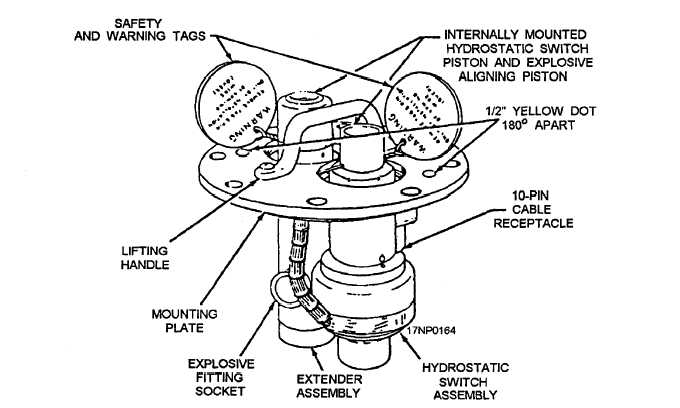Mine Case
The mine case is the main element of the mine. It
contains or carries all other components. The mine case
is normally made of sheet steel, but aluminum, spun
glass, or various plastics are used in some types of mine
cases. The case is watertight and strong to resist water
pressure. Mine case openings are carefully sealed with
suitable gaskets.
Explosive Components
The explosive system of a mine includes the main
charge, the booster, the initiating system, and auxiliary
explosive devices.
MAIN CHARGE.— The main charge is the mine’s
payload. It is a high explosive cast directly into the mine
case, or into an explosive section attached to the mine
case when the mine is assembled. The amount of
explosives used in air-laid mines ranges from 160
pounds to 1,300 pounds. Types of explosives used
include Comp B, TNT, H6, or HBX mixtures. The HBX
mixtures are commonly used explosives.
BOOSTER.— The booster varies from a few
ounces to several pounds of explosive. Generally, the
smaller boosters contain tetryl, and the larger boosters
contain granular grade A TNT. The intermediate size
booster contains Comp B. In some cases, the booster
consists of a subbooster. The booster is housed in either
a brass, terneplate, plastic, or fiber container. When
assembled in the mine case, the booster is in intimate
contact with the main charge explosive,
INITIATING SYSTEM.— An electric primer in
an explosive fitting is used to set off a flash detonator.
This initiates the leads to the booster or subbooster,
causing the mine to detonate. Explosive fittings may
contain a primer or a detonator, depending on their
design function.
AUXILIARY EXPLOSIVE DEVICES.—
Auxiliary devices are usually small explosives that blow
or open a hole in the mine case to sink it. A small
explosive device, such as the explosive driver, is used
during the mine planting or operating sequence. For
example, it is used to close or open electrical switches,
unlock mechanical linkages, open gas bottles, and jam
cables from further payout. Other types of auxiliary
explosive devices are used to cut cables and to release
pyrotechnic signals from exercise and training mines.
Arming Components
An arming device (fig. 5-10) is a combination of a
hydrostatic switch piston and an explosive aligning
piston. They are internally mounted in a single
Figure 5-10.—Arming device.
5-9



